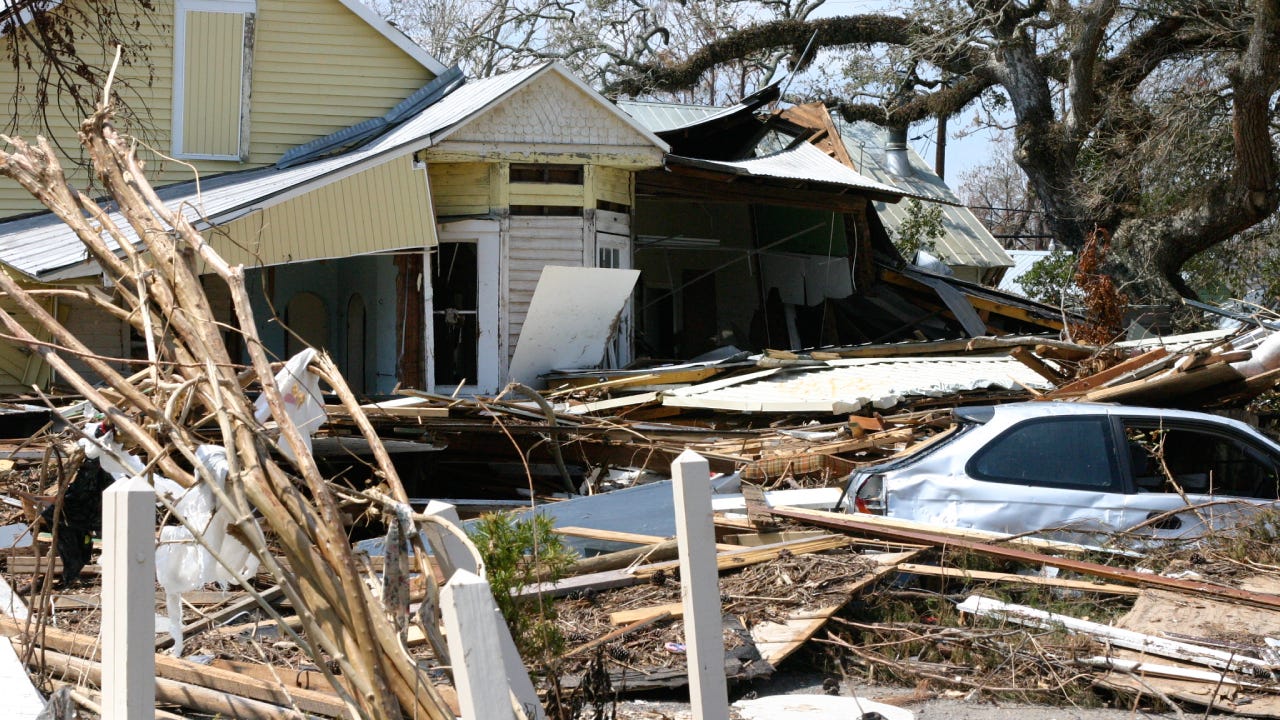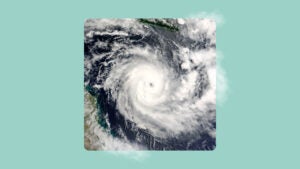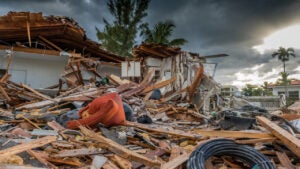You have hurricane damage, now what?: Steps to take after a hurricane

In late September and early October 2024, the American Southeast was hit with two back-to-back major hurricanes Helene and Milton. Homeowners in Florida, Georgia, the Carolinas, Tennessee and Virginia faced down these two historic storms in a less-than-two-week timeframe. To make matters worse, there could be another tropical storm brewing over the Atlantic. If it develops into a named storm, it will be called Nadine. Hurricane Leslie, a Category 1, is also brewing over the Atlantic.
After the storm clears out, facing the wreckage can be overwhelming for a national and local government, let alone a homeowner. If you’ve recently experienced a hurricane, here’s what to do to start the recovery process.
1. Do not return to your home until you receive reentry orders
It is paramount that you follow all evacuation orders issued by local and national authorities. This includes waiting for reentry guidance from the Federal Emergency Management (FEMA) or local government or both. Roads may be wiped out, making driving unsafe. Power lines may also be down, which could create electrical hazards. Wait until you can safely go near your property before checking on your home. If your home is damaged, it will still be damaged once it’s safe to go see it in person.
2. If your home is damaged, apply for the $750 “Serious Needs Assistance” from FEMA as soon as a disaster is declared
When a major hurricane hits, it’s likely that FEMA will declare an area a disaster zone. When this happens, residents of the disaster zone may apply for a one-time payment of $750. Called “Serious Needs Assistance,” this money is different from the larger FEMA grants. It is designed to cover immediate needs like food, water, infant formula, diapers, toilet paper and other emergency items. Here’s how to get it:
| How you qualify for FEMA Serious Needs Assistance | How to get FEMA Serious Needs Assistance |
|---|---|
| Your home is in a declared disaster area. | Apply within the first 30 days of a declared disaster. In some cases, FEMA may extend the deadline to 60 days. |
| You or someone in your household is a U.S. Citizen, non-citizen national or qualified non-citizen | Start your application online, call 800-621-3362 or visit a nearby Disaster Recovery Center (once it is safe to travel) |
| FEMA can confirm your identity | |
| You reside in your home most of the year (vacation homes likely aren’t eligible) | |
| You confirm your home was damaged by the disaster by a FEMA inspection or sending FEMA documentation of the damage |
Not always. If your home resides in one of the most damaged disaster areas, FEMA may issue you your payment before the inspection occurs. However, you may need to send more information confirming your identity, your home’s location or the repairs you need.
3. Think about lodging before home repairs
It’s possible that, after a hurricane, your home isn’t safe to live in. In that case, call your home insurance company to ask specifically about the additional living expenses part of your policy. This coverage, which is usually around 20 to 30 percent of your total dwelling limit, can help with the unexpected costs that arise after being displaced from your home. These may include:
- Hotel rooms
- Restaurant meals
- Laundry
- Pet boarding
- Fuel costs
- Storage fees
If you know your home was in the path of destruction and are already in a hotel, contact your home insurance company to ask if it’s possible to receive funds faster than you would a normal claim. When a major weather event, like a hurricane, happens, home insurance companies may release funds for additional living expenses sooner.
- Text “Shelter” and your ZIP code to 43362 for a list of open shelters near you
- Red Cross Shelter finder
- Free housing from Airbnb.org
- Florida
- For Pinellas, Hernando, Hillsborough, Charlotte, Escambia, Santa Rosa, Holmes, Washington, Bay, Jackson, Calhoun, Walton, Okaloosa, Gulf, Lee, Hendry, Glades, Leon, Taylor, Wakulla, Madison, Liberty, Gadsden, Franklin and Jefferson counties, contact 211.org
- For Sarasota and Manatee counties, call 863-688-5563 or 800-282-8011
- For Pasco county, call 800-995-7604
- North Carolina: Contact 211.org
- South Carolina: Contact 211.org
- Georgia
- For Effingham, Chatham, Bryan, Liberty, Long, Taliaferro, Wilkes, Lincoln, Colombia, McDuffie, Warren, Richmond, Burke, Glascock, Jefferson and Screven counties, call 211
- For Atkinson, Bacon, Berrien, Brooks, Clinch, Coffee, Echols, Jeff Davis, Lanier, Lowndes and Ware counties, call 229-242-2208
- Florida
- Check if a hotel is pet-friendly
- Florida-specific housing resources:
- List of shelters by county
- Check if a shelter is pet-friendly or amenable to other needs
4. Document the damage for your insurance company — but only when it is safe enter your home
To file a home insurance claim, you’ll need to show the storm impact to your home insurance company. It’s important to capture the damage before you begin any cleanup or repairs, but it’s even more important to put your safety first.
Safety steps before going near your home
- Wait until local authorities issue reentry orders.
- Keep away from flood waters.
- Do not flip on light switches. Instead, use a flashlight.
- Smell for gas leaks.
- Avoid touching wires and outlets.
- Look for frayed cords.
- Turn off your main electrical circuit, if you can access it safely. Stand on a dry surface and do not touch the metal handle on the switch box. To throw the switch, use a piece of heavy rubber or wood.
- Check for snakes and other pests.
Once it is safe to enter your home, you can begin to take photos and videos of the damage. It may help to consult your home inventory to get a fuller scope of how much property was damaged.
- Florida Baptist Disaster Relief Public Assistance: 904-253-0502 or text “Helene” to 27123
- Samaritan’s Purse Hotline: 833-747-1234 for free help with removing personal property, furniture, flood cleanup and more
5. Read your policy and adhere to your duties after loss
Most home insurance policies include guidelines of what the policyholder is responsible for doing after damage has occurred. You can often find these guidelines in the “conditions” section of your policy. If you have a digital copy of your home insurance policy, try using the search function for the phrase “duties after loss.”
Your insurance company may deny a claim if it feels you did not take proper action to prevent more damage to your home. You may be responsible for notifying the police (in case of a theft claim), creating an inventory of damaged items and making reasonable and necessary repairs like boarding up a window or tarping a roof. If and when you spend your own money on repair expenses, hang onto your receipts. Your insurance company will likely reimburse you for the money you spent out of pocket.
6. Call your flood insurance company
Remember, home insurance won’t help you when it comes to flood damage since it is an excluded coverage. If you have flood insurance, and your home sustained flood damage, you’ll need to contact your flood insurance provider.
The process is similar to how you’d file a home insurance claim. Document the damage — only when it is safe for you to enter your home to do so — and contact your flood insurance provider. If you have an National Flood Insurance Program (NFIP) policy, you can call 877-336-2627 to be connected with an agent. Or, if you have a private flood provider, follow your provider’s claims instructions.
7. Apply for FEMA aid, if needed
In addition to Serious Needs Assistance, FEMA also offers financial assistance through the Individuals and Households Program (IHP). In order to receive money, you must meet the eligibility criteria.
Eligibility
- You must be a U.S. citizen, non-citizen national or qualified non-citizen
- Your identity must be verified by FEMA
- You own your home
- You live in your home most of the year (vacation homes are usually not eligible)
- Your necessary expenses and serious needs are directly caused by a declared natural disaster
- You apply within 18 months after the date of a Presidential disaster declaration
- A FEMA inspection confirms the damage you’re claiming
- Your insurance or other disaster assistance cannot meet all of your disaster-caused needs
That last point is particularly important. FEMA’s financial aid is meant to fill in the gaps that could be left by your insurance company. If, for example, your coverage limits aren’t high enough to cover the full cost of a new roof, FEMA IHP could potentially help with that. However, if your roof damage was wholly covered by your home insurance policy, you cannot “double dip” by applying for FEMA aid and using the money for something else.
If and when FEMA gives you money, it’s not a blank check. When you receive financial aid from FEMA, you can only use it for a few designated purposes.
What you can use FEMA money for
- Displacement assistance
- Personal property assistance
- Transportation assistance
- Medical and dental assistance
- Funeral assistance
- Child care assistance
- Moving and storage assistance
- Assistance for miscellaneous items
- Group flood insurance policy
- Clean and sanitize assistance
After you receive FEMA funds, you must document what you use your disaster funds for. Be sure to hold onto these records and receipts for at least three years just in case you are audited by FEMA. Notably, FEMA disaster aid is not taxable, nor does it count as income on your tax return.
The maximum amount you can receive from FEMA is $42,500. This includes the Serious Needs Assistance. Exactly how much you receive from FEMA will depend on the results of your FEMA inspection.
Why we ask for feedback Your feedback helps us improve our content and services. It takes less than a minute to complete.
Your responses are anonymous and will only be used for improving our website.
You may also like

What to do with a damaged car after a hurricane

12 ways to avoid hurricane damage

How to prepare your home for hurricane season



